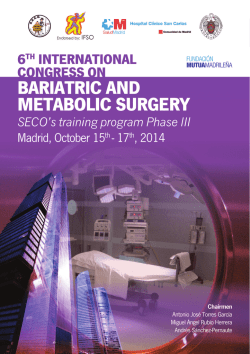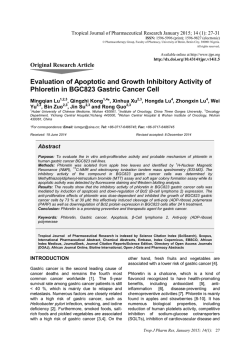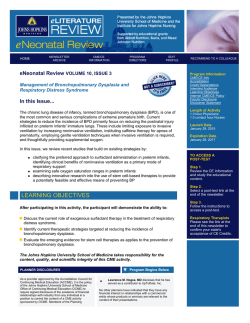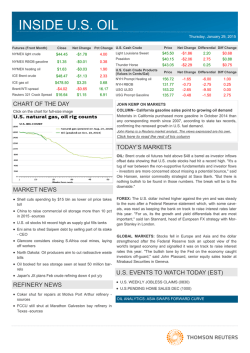
Protein malnutrition incidence comparison after gastric bypass
Nutr Hosp. 2015;32(1):80-86 ISSN 0212-1611 • CODEN NUHOEQ S.V.R. 318 Original / Obesidad Protein malnutrition incidence comparison after gastric bypass versus biliopancreatic diversion José Pablo Suárez Llanos1, Manuel Fuentes Ferrer2, Luis Álvarez-Sala-Walther3, Bruno García Bray1, Laura Medina González4, Irene Bretón Lesmes5 y Basilio Moreno Esteban5 1 Servicio de Endocrinología y Nutrición del Hospital Universitario Nuestra Señora de la Candelaria (HUNSC), Santa Cruz de Tenerife. 2Servicio de Medicina Preventiva del Hospital Clínico San Carlos, Madrid. 3Servicio de Medicina Interna del Hospital General Universitario Gregorio Marañón, Madrid. 4Servicio de Bioquímica Clínica del Hospital Universitario de Canarias, Santa Cruz de Tenerife. 5Servicio de Endocrinología y Nutrición del Hospital General Universitario Gregorio Marañón, Madrid, España. Abstract Background: bariatric surgery is widely employed nowadays. Nutritional complications following malabsorptive bariatric surgery are common. Objectives: to compare protein malnutrition incidence, the amount of protein intake and the influence of various risk factors in patients undergoing Roux-en-Y gastric bypass (RYGB) and biliopancreatic diversion (BPD). Methods: retrospective study comparing the development of hypoalbuminemia in 92 patients undergoing BPD and 121 RYGB, before surgery and 3, 6, 12, 18 and 24 months after it. Protein intake was estimated by serum prealbumin. The influence of prior body mass index (BMI), age and sex was analyzed. Results: hypoprealbuminemia was found in around 40% of patients 3 months after both procedures, decreasing to about 10% after 2 years of surgery. Hypoalbuminemia incidence was close to 20% in the first post-surgery year in BPD, persisting in 10-15% of cases thereafter. After RYGB, hypoalbuminemia incidence was lower (5-9% in all postoperative follow-up measurements). During the first year after surgery, hypoalbuminemia was more frequent after BPD than after RYGB (at the 3rd month (OR:3.9; p=0.006; 95%CI:1.5-10.4), 6th (OR:5.0; p=0.002; 95% CI:1.8-13.8), and at the 12th month (OR:4.4;p=0.007;95%;CI:1.5-12.8)), but not after the first year. A higher preoperative BMI favored it (OR: 1.03; p=0.046; 95% CI:1-1.06), as well as greater age during the first 6 months. Conclusion: Patients with BPD had a higher risk for hypoproteinemia than those undergoing RYGB, especially during the first year post-surgery. Higher preoperati- Correspondence: José Pablo Suárez Llanos. Servicio de Endocrinología y Nutrición del Hospital Universitario Nuestra Señora de Candelaria (HUNSC). Ctra. Del Rosario nº145. 38010, Santa Cruz de Tenerife, España. E-mail: [email protected] COMPARACIÓN DE LA INCIDENCIA DE MALNUTRICIÓN PROTEICA TRAS BYPASS GÁSTRICO VERSUS DERIVACIÓN BILIOPANCREÁTICA Resumen Introducción: la cirugía bariátrica es muy empleada actualmente y en las malabsortivas, las complicaciones nutricionales son habituales. Objetivos: comparar la incidencia de malnutrición proteica e ingesta estimada de proteínas en pacientes intervenidos de bypass gástrico en Y-de-Roux (BGYR) y derivación biliopancreática (DBP), y la influencia de algunos factores de riesgo. Métodos: estudio restrospectivo comparando el desarrollo de hipoalbuminemia en 92 pacientes intervenidos mediante DBP y 121 de DBP (prequirúrgico, a los 3, 6, 12, 18 y 24 meses postquirúrgicos). La ingesta proteica se estimó mediante prealbúmina. Se evaluó la influencia del índice de masa corporal (IMC) previo, la edad y el sexo. Resultados: se encontró hipoprealbuminemia en torno al 40% de los pacientes a los 3 meses tras ambas técnicas, disminuyendo hasta el 10% a los dos años. La incidencia de hipoalbuminemia fue cercana al 20% durante el primer año tras DBP, persistiendo posteriormente en un 10-15% de los casos. Tras el BGYR, dicha incidencia fue menor (5-9% en todos los momentos). Así, durante el primer año postquirúrgico la hipoalbuminemia fue más frecuente tras DBP [3 meses: (OR:3,9;p = 0,006; 95%CI:1,510,4), 6 meses (OR:5,0; p = 0,002; 95% CI:1,8-13,8), y al año (OR:4,4;p = 0,007;95%;CI:1,5-12,8)], pero no así después. Un mayor IMC prequirúrgico favoreció la inicidencia de hipoalbuminemia (OR:1,03; p = 0,046; 95% CI:1-1,06), así como una mayor edad a los 6 meses postquiúrgicos. Conclusión: los pacientes intervenidos mediante DBP tuvieron mayor riesgo de presentar hipoproteinemia que tras BGYR, especialmente durante el primer año postquirúrgico. Un mayor IMC postquirúrgico y la edad Recibido: 28-III-2015. Aceptado: 20-IV-2015. 80 013_8963 Comparacion de la incidencia.indd 80 16/06/15 21:08 ve BMI, and age (in the short-term period) could have a significant inverse relation to hypoproteinemia. (a los 6 meses) podrían favorecer la aparición de hipoproteinemia. (Nutr Hosp. 2015;32:80-86) (Nutr Hosp. 2015;32:80-86) DOI:10.3305/nh.2015.32.1.8963 DOI:10.3305/nh.2015.32.1.8963 Key words: Obesity. Bariatric surgery. Protein malnutrition. Prealbumin. Serum albumin. Palabras clave: Obesidad. Cirugía bariátrica. Malnutrición proteica. Prealbúmina. Albúmina sérica. Abbreviations increases due to a better protein tolerance over time. In addition, no relevant differences in protein malnutrition have been observed in the few studies that compare both surgical procedures8-15. In the study of Rinaldi et al., a correlation between prealbumin and protein intake in these patients was observed. Although more studies are needed in this regard, such contributions could be a good marker of protein intake3. Few studies have assessed the determination of prealbumin after bariatric mixed techniques, mainly finding deficiencies during the first year after both RYGB12,13,16 and BPD13. Most of the studies published to date provide protein malnutrition data after performing a particular surgical procedure, but few compare its incidence after the two most common procedures (classical RYGB and BPD)10,11. The purpose of this study is to estimate and compare protein malnutrition incidence after each technique (Larrad BPD was used)15, and to analyse how some preoperative factors influence its appearance. This study is the first to estimate and compare protein malnutrition incidence after RYGB and Larrad BPD, and how several preoperative factors influence its appearance. RYGB: Roux-en-Y gastric bypass. BPD: biliopancreatic diversion. BMI: body mass index. OR: odd ratio. EWL: excess weight lost. EBMIL: excess BMI lost. %EWL: percentag of excess weight lost. %EBMIL: percentage of excess BMI lost. Introduction Very commonly, lifestyle modifications and medical treatment fail to achieve significant weight loss in the follow up of obese patients. This leads to bariatric surgery being widely employed nowadays, remaining the most effective treatment option for a sustained weight loss over time, especially in patients with morbid obesity. The surgical techniques most commonly used in morbid obese patients are gastric bypass with Rouxen-Y anastomosis (RYGB), which has a higher restrictive component and is partially malabsorptive, and biliopancreatic diversion (BPD), primarily malabsorptive in all of its forms. One procedure or another is performed depending on the severity of the patient’s obesity or the surgeon´s experience with each procedure1,2. Obese patients have a high risk of hypoproteinemia before surgery, as they may have comorbidities that favor it3-5. The surgery itself causes an increase in organic stress, protein needs, along with an anorexic state in the immediate postoperative period, and can trigger possible infectious or mechanical complications that can appear after the intervention. In the mixed bariatric techniques, gastrectomy (more importantly in RYGB) and intestinal malabsorption (higher in BPD) mechanisms are combined. Gastrectomy causes early satiety which limits intakes6, especially of proteins (with greater satiating power), mostly in the short and medium term. The effect of intestinal malabsorption on protein balance can be long lasting, caused by a very short alimentary limb added to a fast intestinal transit2,7. In BPD it appears that endogenous nitrogen loss by the lack of enteric enzymes or by the presence of bacterial overgrowth may be greater than the apparent protein loss by malabsorption alone8. In any case, moderate to severe protein malnutrition is rare after any of these techniques, usually disappearing when protein intake Protein malnutrition incidence comparison after gastric bypass versus biliopancreatic diversion 013_8963 Comparacion de la incidencia.indd 81 Materials and methods Comparative study of two retrospective clinical nonconcurrent cohorts in which the occurrence of protein deficiencies in 92 patients operated by classic RYGB (from 2002 onwards), and 121 operated by BPD with the Larrad modified technique (up to 2004), was assessed. This variation in surgical procedure performed was due to the change in the team of surgeons practising in the hospital. The Larrad variant consists of a surgical subcardial gastrectomy (about 4/5), and an intestinal bypass that lengthens the alimentary canal (by > 300 cm), preserving most of the jejunum and ileum, and shortens the biliopancreatic limb (by 50 cm), while the common channel maintains the same length as the classical Scopinaro technique (14). In RYGB, however, a gastrectomy is performed with a gastric pouch of 15ml capacity separated from the rest of the stomach, and the jejunum anastomosed using a Roux-en-Y assembly. The biliopancreatic limb measures 50-150 cm, the alimentary limb 50-250 cm, while the common channel measures between 150 and 250 cm, depending on the degree of pre-obesity. Nutr Hosp. 2015;32(1):80-86 81 16/06/15 21:08 Patients were excluded if they had coexisting pathology that could alter the nutritional parameters (moderate to severe renal or hepatic failure, intestinal maldigestion or malabsorption unrelated to surgery, or serious postoperative complications) and those who did not attend periodical medical reviews. The preoperative characteristics are shown in table I. In addition to preoperative data, 3, 6, 12, 18 and 24 months post-surgery anthropometric data were collected. Plasma albumin was measured during the consultations, as an indicator of protein malnutrition. The latter was classified according to albumin levels (g/ dl) in: mild (2,8-3,5); moderate (2,1-2,79); and severe (<2,1) malnutrition. Protein intake was also studied by measuring serum prealbumin at each postoperative visit (deficiency if levels <16,7 mg/dl). The amount of protein intake after each type of surgery is also estimated by measuring serum prealbumin levels, seeking to provide information that may help to clarify the frequency of this nutritional complication, thus helping to prevent it if necessary. We evaluated the possible influence of prior body mass index (BMI), age and sex in the evolution of these protein parameters. All patients included in this study were instructed to follow a progressive phased diet in addition to a hyperproteic nutritional supplements intake that provided 15 to 30 g/protein/ day and 400 kcal/day for approximately the first three months. Furthermore, a multivitamin complement and calcium and vitamin D (1000 mg and 800 IU/day respectively) was given postoperatively. comparisons between the two groups, the t-student test for quantitative variables was used. We conducted analysis of variance for repeated measures (ANOVA) to compare the evolution of anthropometric variables between the two study groups in relation to time (interaction effect between group and time). The cumulative incidences and their 95% confidence intervals were calculated at each post-surgery evaluation. A multiple logistic regression model evaluated the influence of prior BMI, age and sex in the incidence of hypoalbuminemia at each post-surgery period adjusted for baseline albumin levels. All the results of the regression models were presented using the odds ratio (OR) and its 95% confidence intervals. The null hypothesis was rejected by a type I error <0,05 (α <0,05). Statistical analyses were performed using SPSS 15.0 (SPSS Inc., Chicago, Illinois, USA). Results The number of subjects on whom data have been obtained on the variables of interest at each follow-up (baseline, 3 months, 12 months, 18 months and 2 years) was 86, 81, 81, 70 and 58 in the RYGB procedure group, while in the Larrad group it was 102, 105, 111, 100 and 106. The percentage of patients loss at each follow up was compared between the two groups without finding statistically significant differences, except at the 2-year follow-up (p <0,001). Weight loss Statistical analysis Qualitative parameters were summarized by their frequency distribution and quantitative parameters by their mean and standard deviation (m ± SD). The last observation carried forward (LOCF) method was used to impute missing post-baseline data. According to the basal characteristics in case of qualitative measurements, comparison was evaluated by the X2 test, or by Fisher’s exact test if more than 25% of the expected values were less than five. For Weight loss results are presented in table II. Weight loss is similar at 24-month follow-up of both procedures (p = 0,105). There was a significant reduction of BMI in patients undergoing BPD (p = 0,037). No differences were found in the percentage of excess weight lost (% EWL) between both groups (p=0,649), so that after RYGB there was a 61,4 ± 20,9% loss after two years, whereas after BPD there was a 62,6 ± 17% (p = 0,649). Also, there were no differences in the percentage of excess BMI lost (%EBMIL) (p = 0,285), so that after RYGB it decreased in 70,8 ± 17,9% and 67,6 ± 18,5% after BPD. Table I Preoperative patient characteristics GB BPD Nº of patients 92 (43.2%) 121 (56.8%) Sex (Women) 68 (73.9%) 90 (74.4%) 0.531 Weight (kg)* 139.1 (20.6) 144.6 (26.7) 0.102 BMI (kg/m )* 51.4 (6.5) 54.5 (8.9) 0.005 Albumin (g/dl)* 3.8 (0.3) 4.0 (0.5) <0.005 Age* 39.1 (8.1) 38.9 (9.7) 0.867 2 p * Mean and standard deviation 82 013_8963 Comparacion de la incidencia.indd 82 Nutr Hosp. 2015;32(1):80-86 Prealbumin Serum prealbumin was measured in 84 patients that underwent RYGB and 106 that underwent BPD. There was no difference between the two procedures in the levels of this parameter at any time after surgery. The prealbumin deficiency incidence was 40% in both groups at 3 months post-surgery, having a similar evolution in the following months, and falling progressively, reaching around a 10% decrease two years after both surgical procedures (Fig. 1). José Pablo Suárez Llanos et al. 16/06/15 21:08 Table II Anthropometric changes after both bariatric procedures. GB Initial data 3 Months 6 Months 12 Months 18 Months 24 Months BPD p n Mean SD n Mean SD Weight 92 139.1 20.59 121 144.63 26.68 BMI 92 51.4 6.51 121 54.51 8.90 Weight 92 118.2 19.64 121 120.77 22.55 BMI 92 43.8 7.10 121 45.49 7.31 %EWL 92 27.0 14.18 120 28.61 10.39 %EBMIL 82 33.3 12.73 120 31.37 11.05 Weight 92 103.9 20.05 121 105.16 21.17 BMI 92 38.5 7.16 121 39.65 7.32 %EWL 92 45.7 18.73 120 48.48 13.34 %EBMIL 82 55.3 14.24 120 52.40 14.73 Weight 92 93.9 19.38 121 95.84 19.00 BMI 92 34.8 7.09 121 36.09 6.29 %EWL 92 58.3 21.65 120 58.61 14.81 %EBMIL 82 69.2 15.40 120 63.38 16.35 Weight 92 92.3 20.26 121 92.68 18.14 BMI 92 34.2 7.34 121 34.95 6.21 %EWL 92 60.5 22.63 120 61.85 16.07 %EBMIL 82 71.2 17.72 120 66.87 17.68 Weight 92 91.9 20.32 121 91.49 17.08 0.105* BMI 92 34.0 7.12 121 34.49 5.71 0.037* %EWL 92 61.4 20.87 120 62.58 17.00 0.649* %EBMIL 82 70.8 17.88 120 67.60 18.52 0.285* Incidence of Hypoalbuminemia (%) * p value of anthropometric data evolution during the 24 months of follow up. 35 p=0.018 p=0.005 p=0.017 p=0.338 p=0.208 30 25 19,8 19,8 20 16,5 14,9 15 10,7 10 7,6 6,5 5 0 3 months 5,4 6,5 8,7 6 months 12 months 18 months 24 months GB (n=92) BPD (n=121) Fig. 1.—Incidence of hypoalbuminemia in the 24-month follow up period after surgery. Protein malnutrition incidence comparison after gastric bypass versus biliopancreatic diversion 013_8963 Comparacion de la incidencia.indd 83 Albumin Although the average serum albumin levels were within the normal range before performing both procedures, as described in table I, they were significantly greater in patients assigned to undergo BPD. However, the incidence of hypoalbuminemia was significantly higher during the first BPD postoperative year, being close to 20%, whereas after RYGB the incidence was <8%. The incidence of hypoalbuminemia decreased during the second year after BPD (Fig. 2), with no differences between groups in this period after adjusting for BMI, age and sex (Table III). There were no cases of severe hypoalbuminemia after performing either of the surgical techniques. There were only two isolated cases of moderate hypoalbuminemia Nutr Hosp. 2015;32(1):80-86 83 16/06/15 21:08 Incidence of Hypoalbuminemia (%) 70 p=1.000 p=1.000 p=0.385 p=0.498 monstrated significant weight loss in obese patients that persists over time17. Generally, malabsorptive techniques achieve greater weight loss15,18,19,20. In fact, in the only prospective study comparing gastric bypass and BPD, conducted in patients with BMI between 35 and 50 kg/m2, EWL was significantly greater after BPD, both after one year (EWL 73,7% after RYGB, and 83,1% after BPD) and after two years (72,6% after RYGB, and 83,1% after BPD11. Larrad modified BPD has shown similar results, with 69% EWL, which stabilizes at 18-24 months after surgery. The EWL reaches 80% in the morbidly obese and 62% in the super obese up to 5 years15,19, similar to that obtained in our study (also super obese patients with average preoperative BMI> 50 kg/m2). In our study, however, no significant differences were found between both groups regarding EWL and EBMIL, probably because the patients that underwent BPD started from a higher weight and BMI (5,5 kg, not significant, and 4,1 kg/m2 with p<0,005, respectively), and when applying the formula in percentage, patients with more room for improvement obtain lower percentages. As for BMI, the total decline over two years is greater after the Larrad technique, partly because preoperative BMI was significantly higher in these patients. One of the possible nutritional complications of these surgical techniques is the appearance of protein malnutrition. A mild hypoalbuminemia can often occur after RYGB in the short term and even before surgery21,22, but it is rare for moderate to severe hypoalbuminemia to appear after this procedure, even in the short or medium term9,14,23. In the various series of BPD clinically significant postoperative hypoalbuminemias are not usually observed8,13,20. Other studies following the Larrad technique in the short to medium term, showed that one-quarter of patients had isolated episodes of hypoalbuminemia in the first year, whereas there was only one case of severe hypoalbuminemia that required parenteral nutri- p=1.000 60 50 40 7,6 19,8 6,5 19,8 30 16,5 5,4 20 6,5 10 0 3 months 10,7 8,7 14,9 6 months 12 months 18 months 24 months GB (n=84) BPD (n=106) Fig. 2.—Incidence of hypoprealbuminemia in the 24-month follow up period after surgery. after RYGB at 6 months post-surgery, becoming normal after adequate protein intake and no longer appearing at 12 months post-surgery. However, after the completion of BPD, 5 patients had moderate hypoalbuminemia during the first year after surgery. Only one patient remained hypoalbuminemic during the second year. Table III shows the effects of sex, age and preoperative BMI on the incidence of hypoalbuminemia in the different periods evaluated. Increasing age has a statistically significant correlation with the probability of hypoalbuminemia at 3 and 6 months post-surgery. Gender showed no difference in any of the evaluated periods. We found a significant association between preoperative BMI and the likelihood of malnutrition two years after surgery, so that for every kg/m2 there was a 6% increased risk of developing hypoalbuminemia. Discussion Bariatric surgery, with a restrictive and a malabsorptive component (both BPD as RYGB) has de- Table III Multivariate logistic regression models for hypoalbuminemia malnutrition, adjusted for baseline albumin levels Prior BMI Female sex Age Larrad OR p OR p OR p OR p 3 months 1.04 (0.99-10.96) 0.091 1.14 (0.40-3.3) 0.806 1.06 (1.01-1.11) 0.029 3.94 (1.50-10.41) 0.006 6 months 1.02 (0.98-1.07) 0.337 0.52 (0.20-1.34) 0.173 1.05 (1.00-1.11) 0.045 4.98 (1.80-13.81) 0.002 12 months 1.01 (0.96-1.06) 0.706 0.99 (0.35-2.79) 0.985 0.99 (0.95-1.04) 0.886 4.40 (1.50-12.84) 0.007 18 months 0.99 (0.93-1.05) 0.759 1.30 (0.40-4.26) 0.659 0.98 (0.93-1.03) 0.417 2.16 (0.74-6.28) 0.158 24 months 1.06 (1.01-1.11) 0.018 0.99 (0.37-2.66) 0.994 1.00 (0.96-1.05) 0.839 1.33 (0.51-3.50) 0.558 OR: odds ratio. 84 013_8963 Comparacion de la incidencia.indd 84 Nutr Hosp. 2015;32(1):80-86 José Pablo Suárez Llanos et al. 16/06/15 21:08 tion in a patient previously diagnosed with anorexia nervosa19. Also, no significant differences were found in the few studies comparing BPD with RYGB10,11,12. Our study showed similar results to those reported in the literature, with no cases of severe hypoalbuminemia, and some isolated moderate ones which did not require specific treatment. Our findings of mild protein malnutrition are also within the ranges described in the literature8-15,19,23. Post surgical low protein intake is the most common cause of protein malnutrition in these patients. Rinaldi et al. observed that in patients undergoing RYGB, for every 0,5 g of protein intake/kg ideal body weight/day, there was a statistically significant increase of 2,34 mg/dl of plasma prealbumin (this being therefore a good indicator of protein intake) and an increase of 0,11 g/dl of serum albumin3. In our sample of patients, there was a hypoprealbuminemia rate of about 40% 3 months after the surgery in both groups, reflecting a low protein intake in these patients, which decreased progressively to about 10% after 18 months as food tolerance, and therefore protein intake, improved. Often, the protein intake of these patients is not enough during the first year9,12,13,24, even after providing recommendations for an intake of at least 60 g/day and high protein supplements for the first 3 months, as done in this study25. Since hypoprealbuminemia incidence and evolution were similar between the two procedures, we cannot justify this cause as an explanation of the differences seen in protein malnutrition during the first year. In addition, preoperative mean plasma albumin was higher in the BPD intervention group, leading us to believe that the reason for the differences found lies between surgery and the early postoperative period. In this sense, early complications are not registered in this study, although a higher incidence, as well as a higher average hospitalization in patients undergoing BPD compared to RYGB has been described previously26,27. This usually causes an increase in protein catabolism, which may be an explanation for the results obtained. In our study, older patients were more likely to develop protein malnutrition within the first 6 months, although there were no differences in patient age between groups. Still, this point should be considered when assessing whether age is really a risk factor for the development of this nutritional complication, as shown in a previous study28. Conclusions Protein malnutrition has a significant effect on these patients, especially in the short term after the completion of BPD (in our case by the Larrad modified technique), so it should be prevented based on strict nutritional recommendations. Prealbumin and albumin levels can be very informative in this regard, Protein malnutrition incidence comparison after gastric bypass versus biliopancreatic diversion 013_8963 Comparacion de la incidencia.indd 85 so it would be advisable to measure them, especially during the first year after surgery. References 1. Mechanick JI, Kushner RF, Sugerman HJ, et al. American Association of Clinical Endocrinologists, The Obesity Society, and American Society for Metabolic & Bariatric Surgery medical guidelines for clinical practice for the perioperative nutritional, metabolic, and nonsurgical support of the bariatric surgery patient. Obesity 2009;17:S1-70. 2. Miller MR, Choban PS. Surgical management of obesity: current state of procedure evolution and strategies to optimize outcomes. Nutr Clin Pract 2011;26:526-533. 3. Rinaldi SE, Pettine SM, Adams E, Harris M. Impact of varying levels of protein intake on protein status indicators after gastric bypass in patients with multiple complications requiring nutritional support. Obes Surg 2006;16:24-30. 4. Moize V, Deulofeu R, Torres F, de Osaba JM, Vidal J. Nutritional Intake and Prevalence of Nutritional Deficiencies Prior to Surgery in a Spanish Morbidly Obese Population. Obes Surg 2011;21:1382-8. 5. Ernst B, Thurnheer M, Schmid SM, Schultes B. Evidence for the necessity to systematically assess micronutrient status prior to bariatric surgery. Obes Surg 2009;19:66-73. 6. Amaya García MJ, Vilchez López FJ, Campos Martín C, Sánchez Vera P, Pereira Cunill JL. Micronutrientes en cirugía bariátrica. Nutr Hosp 2012:27:349-361. 7. Scopinaro N. Biliopancreatic diversion: mechanisms of action and long-term results. Obes Surg 2006;16:683-9. 8. Scopinaro N, Marinari G, Camerini G, Papadia F. Biliopancreatic diversion for obesity: state of the art. Surg Obes Relat Dis 2005;1:317-28. 9. Moize V, Geliebter A, Gluck ME, Yahav E, Lorence M, Colarusso T, Drake V, Flancbaum L. Obese patients have inadequate protein intake related to protein intolerance up to 1 year following Roux-en-Y gastric bypass. Obes Surg 2003;13:23-8. 10. Skroubis G, Sakellaropoulos G, Pouggouras K, Mead N, Nikiforidis G, Kalfarentzos F. Comparison of nutritional deficiencies after Roux-en-Y gastric bypass and after biliopancreatic diversion with Roux-en-Y gastric bypass. Obes Surg 2002;12:551-8. 11. Skroubis G, Anesidis S, Kehagias I, Mead N, Vagenas K, Kalfarentzos F. Roux-en-Y gastric bypass versus a variant of biliopancreatic diversion in a non-superobese population: prospective comparison of the efficacy and the incidence of metabolic deficiencies. Obes Surg 2006;16:488-95. 12. Ritz P, Becouarn G, Douay O, Salle A, Topart P, Rohmer V. Gastric Bypass is not Associated with Protein Malnutrition in Morbidly Obese Patients. Obes Surg 2009;19:840-4. 13. Salle A, Demarsy D, Poirier AL, Lelievre B, Topart P, Guilloteau G, Becouarn G, Rohmer V. Zinc deficiency: a frequent and underestimated complication after bariatric surgery. Obes Surg 2010;20:1660-70. 14. Dalcanale L, Oliveira CP, Faintuch J, Nogueira MA, Rondó P, Lima VM, Mendonça S, Pajecki D, Mancini M, Carrilho FJ. Long-term nutritional outcome after gastric bypass. Obes Surg 2010;20:181-7. 15. Larrad-Jimenez A, Diaz-Guerra CS, de Cuadros BP, Lesmes IB, Esteban BM. Short-, mid- and long-term results of Larrad biliopancreatic diversion. Obes Surg 2007;17:202-10. 16. Coupaye M, Puchaux K, Bogard C, Msika S, Jouet P, Clerici C, Larger E, Ledoux S. Nutritional consequences of adjustable gastric banding and gastric bypass: a 1-year prospective study. Obes Surg 2009;19:56-65. 17. Giraldo Villa A, Serna López AM, Mustiola Calleja KG, López Gómez LM, Donado Gómez J, Toro Escobar JM. Factores relacionados con la pérdida de peso en una cohorte de pacientes obesos sometidos a bypass gástrico. Nutr Hosp 2013;28:623630. Nutr Hosp. 2015;32(1):80-86 85 16/06/15 21:08 18. Brolin RE, LaMArca LB, Kenler HA, Cody RP. Malabsorptive gastric bypass in patients with superobesity. J Gastrointest Surg 2002;6:195-203. 19. Sanchez-Cabezudo C, Larrad-Jimenez A, Ramos García I, Moreno-Esteban B. Five-year results of Larrad Biliopancreatic bypass in the treatment of morbid obesity. Cir Esp 2001;70:133-141. 20. Kalfarentzos F, Papadoulas S, Skroubis G, Kehagias I, Loukidi A, Mead N. Prospective evaluation of biliopancreatic diversion with Roux-en-Y gastric bypass in the super obese. J Gastrointest Surg. 2004;8:479-488. 21. Faintuch J, Matsuda M, Cruz ME, Silva MM, Teivelis MP, Garrido AB Jr, Gama-Rodrigues JJ. Severe protein-calorie malnutrition after bariatric procedures. Obes Surg 2004;14:175-81. 22. Higa K, Ho T, Tercero F, Boone KB. Laparoscopic Rouxen-Y gastric bypass: 10-year follow-up. Surg Obes Relat Dis 2010;7:516-25. 23. Laurenius A, Taha O, Maleckas A, Lonroth H, Olbers T. Laparoscopic biliopancreatic diversion/duodenal switch or lapa- 86 013_8963 Comparacion de la incidencia.indd 86 Nutr Hosp. 2015;32(1):80-86 24. 25. 26. 27. 28. roscopic Roux-en-Y gastric bypass for super-obesity-weight loss versus side effects. Surg Obes Relat Dis 2010;6:408-14. Andreu A, Moize V, Rodriguez L, Flores L, Vidal J. Protein intake, body composition, and protein status following bariatric surgery. Obes Surg 2010;20:1509-15. Moize V, Andreu A, Rodriguez L, Flores L, Ibarzabal A, Lacy A, Jimenez A, Vidal J. Protein intake and lean tissue mass retention following bariatric surgery. Clin Nutr 2013;32:550-550. Topart P, Becouarn G, Ritz P. Comparative early outcomes of three laparoscopic bariatric procedures: sleeve gastrectomy, Roux-en-Y gastric bypass, and biliopancreatic diversion with duodenal switch. Surg Obes Relat Dis 2012;8:250-4. de la Matta-Martín M, Acosta-Martínez J, Morales-Conde S, Herrera-González. A Perioperative morbi-mortality associated with bariatric surgery: from systematic biliopancreatic diversion to a tailored laparoscopic gastric bypass or sleeve gastrectomy approach. ObesSurg. 2012;22:1001-7. Cossu ML, Fais E, Meloni GB, Profili S, Masala A., Alagna S. Impact of age on long-term complications after biliopancreatic diversion. Obes Surg 2004;14:1182-6. José Pablo Suárez Llanos et al. 16/06/15 21:08
© Copyright 2025








